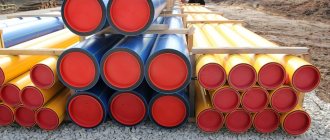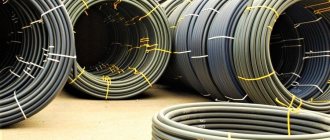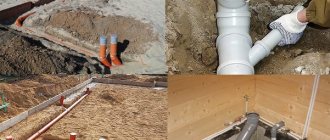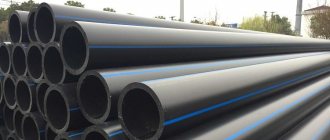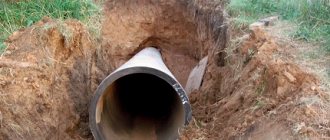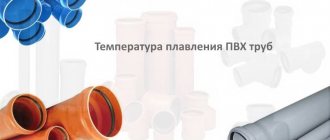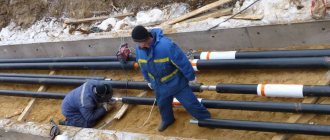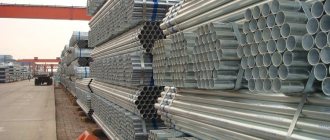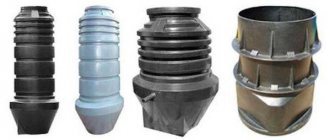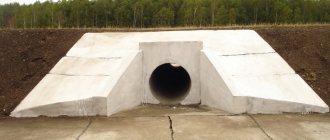One of the most important issues during autonomous gasification of a home is compliance with fire safety standards and requirements. Even at the design stage, you need to clearly know which gas pipes are suitable for external and internal installation.
A successful combination of their different types will ensure maximum reliability of the pipeline.
- Methods for joining polymer structures
HDPE gas pipe wholesale.
You can buy HDPE gas pipes wholesale in our store or pick up a batch from the plant in the Moscow region. First decide what diameter of products you require. Delivery is carried out both in coils and in lengths. The length depends on the diameter. Our company itself produces HDPE gas pipes and can provide them to you in the required quantity. The main advantage is that you make a purchase directly from the manufacturer, bypassing numerous intermediaries. As a result, you manage to save significantly.
If you make a large wholesale purchase, then your benefits become more than obvious. You can choose pipes with a diameter from 20 to 315 mm. The company is well aware that picking up a large shipment on your own can be problematic. Therefore, here you will be offered prompt delivery in compliance with all requirements.
You can submit a purchase application right now. After this, the manager will contact you. This is necessary in order to accurately determine the technical characteristics of the products and the scope of delivery. If you have any questions, you can ask them to specialists. By the way, our company has all the necessary certificates to engage in the production and sale of HDPE pipes. So you can safely use them to lay gas pipelines to industrial and residential premises.
Features of installation work
Installation is carried out by butt or electrofusion welding using connecting parts with embedded heaters. The choice of welding method is determined by the diameter of the pipes, availability of access to the installation site, and budget requirements. Welding equipment can be rented, which allows you to reduce the cost of the finished pipeline if the project is a one-time project.
The manufacturer offers a wide range of complete shut-off and control valves and fittings for gas pipelines of any diameter, which makes it possible to easily install any section, including connection to existing steel pipes. If the technology is followed, the strength of the connections exceeds the strength of the pipe itself and guarantees the elimination of ruptures and other joint defects.
Qualified personnel who have been trained and regularly certified to work with welding equipment in accordance with the established work regulations are allowed for installation.
HDPE gas pipe retail.
In addition to wholesale quantities, you can buy HDPE gas pipes at retail from us. Yes, the cost of each specific unit in the case of retail sales is higher than in wholesale purchases, but what to do if you simply do not need a large number of pipes.
You can immediately pick up the products you are interested in. It doesn’t matter at all what volume of purchase you make. There is no division into batches for wholesale or retail sales. Each unit of product is carefully checked before being handed over to the client. Don't have time to pick up what you ordered yourself? In this case, you can order delivery, which is valid not only in Moscow, but throughout Russia. Please note: transportation is not carried out during severe frosts, as this may negatively affect the performance characteristics of the pipe.
No toxic substances are used in the production process. They have only one application - laying underground pipelines to ensure gas supply. If you made a mistake in your calculations and you don’t have enough pipes, then you can easily make a retail or small wholesale purchase from our company. You just need to decide on the basic characteristics (SDR, diameter). Our specialists will help you understand everything and avoid mistakes when purchasing.
Where to buy HDPE gas pipes in Moscow?
Moscow is a huge city that constantly requires the installation of new communications and the replacement of outdated ones. There is often a need to urgently purchase gas pipes. In such a hurry, no one will wait for them to arrive from other regions. buy HDPE gas pipes in Moscow from us. Sales are carried out at retail and wholesale in any volume.
The production itself is located in the Moscow region, so we are able to deliver large orders on the same day. Most types of products are available in a warehouse in the Moscow region, and if the required quantity is not enough, we will connect additional production capacity. Delivery in Moscow is carried out using our own transport. You can also pick up directly from the factory.
What determines the price of a gas HDPE pipe?
There are several parameters that affect the price of a HDPE gas pipe. First of all, it is the diameter. In our company it varies from 20 to 315 mm. As a result, there is such a wide range of prices. Also look at the wall thickness. The amount of material spent largely depends on this indicator.
In addition, we should not forget about the production technology and equipment used. Due to the fact that our plant uses modern technology, prices are kept at an affordable level. The cost of each specific unit depends on the size of the lot. For example, retail purchases are much less profitable than wholesale purchases. Be sure to pay attention to the SDR indicator. It determines how much pressure the pipe can withstand. The most common are SDR 13.6, 11, 9. They can withstand pressures of 6, 10, 12 atmospheres. Pipes with SDR 26 are considered the most budget-friendly. They are capable of functioning normally at pressures of up to 4 atm.
PE 100 is used in production; we are guided by the requirements of GOST R 50838–2009. So there is no point in saving and purchasing some cheaper substitutes from competitors. Yes, you can save money in the moment, but the service life will definitely be noticeably shorter. Also, no one can guarantee compliance with all security requirements.
Fittings for HDPE gas pipes.
Fittings for gas HDPE pipes are used in the following situations:
- For connecting pipelines having the same or different outer diameters;
- For installation of branches from the main pipeline;
- Installation of plugs at the end parts of the line.
The connections must withstand operating pressure and be resistant to aggressive groundwater. They are classified according to the following criteria:
- According to the installation method. In this case, they are divided into electric welded, cast, welded and compression.
- They can have a rigid or flexible structure depending on where they will be installed.
- There are collapsible and non-detachable.
Compression fittings are not used very often and are used for installation without welding. They are a detachable connection that allows you to quickly replace a section of a gas pipeline. They have a durable polyethylene body, clamping and sealing rings that protect connections from accidental damage. The pipes are pressed rigidly using bushings, and caps cover the joint. Used in low pressure gas networks.
Fittings are either cast or welded. They have different diameters from 63 to 325 mm. With their help you can mount any branches and plugs. Electric-welded connecting fittings are used in hard-to-reach places. It has a heating wire pressed into the joint. During installation, the metal is heated by electric current and melts the plastic. The result is an even and strong connection. Used for the construction of underground gas pipelines of complex configuration.
Cast fittings are considered the most reliable. They are connected to pipes using butt welding. Can withstand pressure up to 20 atm. Manufactured from PE 100 by high pressure casting. They are used for construction within neighborhood gas networks in the public and private sectors.
To connect sections of a gas pipeline made of steel and polyethylene, permanent joints of the polyethylene-steel type (NSPS) are used. Manufactured in a factory. With their help, you can install steel fittings on polyethylene pipelines and replace steel pipes with plastic ones.
Scope of application
Pipes for gas pipelines made from HDPE are used in almost all areas of business:
- small construction: for gasification of individual buildings and entire turnkey villages, including new and existing facilities;
- rehabilitation of existing highways;
- capital construction: to connect new houses and social facilities;
- industry: to meet the needs of production of various types and scales;
- agriculture: to meet the heating needs of crop and livestock farms;
- strategic objects: maintaining the functionality of storage facilities, creating auxiliary infrastructure for gas transport pipelines.
Polyethylene gas pipes from the manufacturer.
There are many reasons why it is recommended to buy gas polyethylene pipes from the manufacturer: low cost, stability of supply and proven quality. In addition, it is worth noting the complete package of documents, without which no serious construction is possible. Our plant has its own laboratory, so there is no doubt about the quality of the products.
Low price HDPE pipes for gas.
It's no secret that the more intermediaries, the higher the cost. Surprisingly, nowadays it is not so easy to contact the manufacturer of HDPE gas pipes directly. Many enterprises that declare themselves as factories mostly produce products in small batches in limited volumes. If they receive requests for large quantities, they become unable to fulfill them and transfer the order to a really large production, that is, to us. This results in a simple thing - the price increases significantly, because in fact, such small companies act as ordinary “outbidders”.
Reliability of supplies in any volume.
Purchasing from intermediaries can lead to missed deadlines, since large production facilities are often fully loaded and fulfill direct orders from their own customers. A compromise option is to purchase finished products from dealers. However, there are two drawbacks. Firstly, the price is, although not much, still higher. Considering the need for hundreds of meters, the overpayment turns out to be decent. Secondly, not all finished products are in stock. Therefore, the best way to get an excellent price and the required volumes is to conclude a contract with a large plant. Our production is one of the few that are truly capable of fulfilling any order for HDPE gas pipes. In addition, you can buy large-diameter polyethylene gas pipes from us. Small producers cannot afford this.
Quality stability and laboratory control.
When dealing with gas, the quality of the pipe must be checked by a series of tests and confirmed by GOST. Gas HDPE pipes of unknown origin are unlikely to pass the necessary checks. The buyer takes a big risk by purchasing such products without a complete package of documents.
However, we do not encourage you to order a more expensive pipe. The fact is that our plant provides the lowest prices on the market, while all gas HDPE pipes are provided with certificates and fully comply with state standards.
As an example, here are dozens of largest projects throughout Russia. This confirms the excellent quality of the products. For more information about where our polyethylene gas pipes are used, you can contact the company employees by phone. We are confident that you will also become our client and receive reliable pipes at the lowest price.
Delivery speed.
Builders know how important prompt delivery of materials to the site is. The installation start date and the project delivery date depend on this. Pipes are the basis of modern communications; not a single large construction site can do without them.
We guarantee timely deliveries of HDPE gas pipes to anywhere in Russia. We have many schemes for transporting products, from retail to batches of tens of kilometers.
What documents will be needed?
Before proceeding directly with the installation, you will have to start collecting the necessary papers. To do this as quickly as possible, you must immediately prepare a passport, as well as documentation that confirms ownership of the plot and the house located on it.
The next step is to submit an application to the appropriate service. It expresses a desire to gasify the house. Employees will issue a form listing all technical conditions.
The document issued by the gas service is filled out by the specialist involved in drawing up the project. Choose a qualified designer. After all, the result of work and the safety of residents depend on his competence.
According to the project, a gas network is being installed. Sometimes pipes are laid through neighbors' properties. In this case, it is necessary to request written permission from them to carry out this type of work.
In addition to the papers listed above, you will also need to obtain the following documents:
- act of putting gas-powered equipment into operation;
- agreement on the preparation of technical documentation and work;
- permission to supply natural gas and pay for this service;
- document on installation of equipment and gasification of the house.
A chimney inspection will also be required. After this, specialists will issue a corresponding certificate. The last document - permission to gasify a private house - is issued by a local architectural and planning company.
HDPE gas pipes of large diameters.
The production of HDPE pipes is regulated by GOST R 50838-2009, which allows for some deviations in the outer diameter after extrusion. Pipes are made of low-pressure polyethylene grades PE-80 and PE-100. They are used for installation of medium pressure gas pipelines and are classified according to certain parameters:
- The maximum value of gas pressure in the pipeline taking into account the safety factor;
- By outer diameter size;
- By wall thickness;
- Based on the ratio of wall thickness to diameter (derived SDR parameter).
Based on this classification, when designing gas mains, one or another type of pipe is selected. They are sold in coils with a diameter of 20 to 110 mm, and a length of 12 m with an outer diameter of 75-315 mm. The operating pressure in the line depends on the SDR parameter. For example, if this value for PE-80 is 9 units, then the pipe can withstand a pressure of no more than 1.0 MPa, and with a value of 17.6 up to 0.3 MPa. That is, there is an inverse proportional relationship. The value of the safety factor “C” for pressure with the maximum MOP value also depends on the SDR value.
The pipes are joined together using special shaped parts (fittings) or butt welded using a semi-automatic welding machine. In some cases, individual parts of the gas pipeline are connected using a flange connection.
Comparison of HDPE gas pipes with analogues.
Thick-walled HDPE pipes are used for the construction of medium-category gas pipelines with a gas pressure of 0.005 - 0.3 MPa. They ensure the transportation of fuel from gas distribution plants to neighborhoods or streets in suburban villages. Polypropylene pipes are becoming increasingly common. According to some characteristics, they are ahead of HDPE, but for various reasons, they are used only for internal wiring.
Gas pipes made of metal plastic are considered more durable than PE, but the rather complex design of the fittings suggests their use only for internal gas supply and then in rare cases. Despite the fact that polyvinyl chloride pipes are more durable and resistant to aggressive chemicals, they are not used for the construction of gas pipelines. They emit the toxic substance chlorethylene, which is unacceptable in residential premises.
Main classification of gas pipelines
The category of a gas pipeline, depending on the gas pressure, is one of the most important criteria that has a significant impact on the choice of pipe material.
There are 5 main categories of gas network:
- I-A - design with the highest pressure exceeding 1.2 MPa. The diameter of the pipe is 1000-1200 mm, the purpose is to connect thermal stations, turbines and steam plants.
- I - system with high pressure, ranging from 0.6-1.2 MPa. Its purpose is to transport gas and arrange gas distribution points.
- II - pressure is lower than in the previous category, but is still considered high. It fluctuates in the range of 300-600 kPa. The diameter of the pipe is 500-1000 mm, the purpose of the gas pipeline is to deliver gas from gas distributors to industrial facilities, residential and social buildings.
- III - medium pressure design with values of 5-300 kPa. The use of pipes with a diameter of 300-500 mm is allowed. Its purpose is to transport gas from the pipeline to gas distribution points, which are located near residential buildings.
- IV - system with minimal pressure (less than 5 kPa). The diameter of the pipe does not exceed 300 mm, the purpose is to deliver gas from the inlet gas pipeline to residential buildings and directly to the final gas consumption devices.
In addition to the category of the gas pipeline and the pressure value, the choice of pipes is also greatly influenced by the features of their installation and operating conditions - external or internal installation, above-ground or underground. If they are laid in the ground, then you will have to take into account such factors as the depth of freezing, the density and thickness of the soil layer, the likelihood of corrosion processes, and the presence of stray currents.
A ground or air gas pipeline is characterized by ease of installation work to create it, but additional care is required for reliable operation
To ensure stable and long-lasting operation of the gas pipeline, it is necessary to take into account the features of installation and operation at the stage of preparatory and design work, and perform all the analyzes that require gasification standards.
